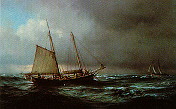
Parks
Website Design and Content
© by Eric Krause, Krause
House Info-Research Solutions (©
1996)
All Images
© Parks Canada Unless Otherwise Designated
Researching the Fortress of Louisbourg National Historic Site of Canada
Recherche sur la Forteresse-de-Louisbourg Lieu historique national du
Canada
Parks
Canada ~ Parcs Canada
Cape Breton ~ Le
Cap-Breton

THIS RESEARCH AND GENEALOGICAL WEBSITE WAS ARCHIVED IN 2010
 Get to know Grassy Island, the
economic centre of Nova Scotia more than 200 years ago, at a time when dried fish were
plentiful, merchants ruled the seas and soldiers waged losing battles. Learn about the
Island's vulnerability to military attack. And see what prompted Grassy Island's sudden
destruction in the spring of 1744.
Get to know Grassy Island, the
economic centre of Nova Scotia more than 200 years ago, at a time when dried fish were
plentiful, merchants ruled the seas and soldiers waged losing battles. Learn about the
Island's vulnerability to military attack. And see what prompted Grassy Island's sudden
destruction in the spring of 1744.
Grassy Island lies in the Atlantic Ocean 0.5km (0.3 mi.) off the Canso waterfront. The Visitor Reception Centre is located in the Town of Canso, on the waterfront off Union Street.
If you're driving from Antigonish, take TransCanada Highway 104 to Exit 37 (Monastery). Follow Route 16 along Chedabucto Bay to Canso. Driving time is 90 minutes. Or take TransCanada Highway 104 to Exit 40 (Aulds Cove) and follow scenic Route 344 past the Strait of Canso to Route 16. Driving time is two hours. From Sherbrooke, take Route 211 to coastal Route 316, then follow Route 16 to Canso. Driving time is two hours.
 Allow 30 minutes to explore the
Visitor Reception Centre. Plan slightly more than one hour to visit Grassy Island: 15
minutes each way by boat and about half an hour to hike the self-guiding trail.
Allow 30 minutes to explore the
Visitor Reception Centre. Plan slightly more than one hour to visit Grassy Island: 15
minutes each way by boat and about half an hour to hike the self-guiding trail.
 See a video, models, maps, illustrations,
photographic displays and exhibits that tell the story of Grassy Island and of the
people who lived and worked there. Get to know a few of Grassy Island's colourful
characters. Three life-size dioramas depict scenes from daily life in 1743. Nearby cases
display related items and hold one of Atlantic Canada's best collections of 18th-century
artifacts.
See a video, models, maps, illustrations,
photographic displays and exhibits that tell the story of Grassy Island and of the
people who lived and worked there. Get to know a few of Grassy Island's colourful
characters. Three life-size dioramas depict scenes from daily life in 1743. Nearby cases
display related items and hold one of Atlantic Canada's best collections of 18th-century
artifacts.  See a scale model of Grassy Island
before the attack of 1744. Watch Grassy Island: The forgotten Settlement, a nine-minute
video on the history of the Island. For adventure, take a short boat ride to the Island
and picnic near the wharf. Hike the interpretive trail around the island to eight
designated sites. Read the self-guiding trail pamphlet, Island Tour Guide, for
descriptions that correspond to the numbers posted along the trail. The dirt trail is
clearly marked; plan to wear hiking boots or sturdy walking shoes.
See a scale model of Grassy Island
before the attack of 1744. Watch Grassy Island: The forgotten Settlement, a nine-minute
video on the history of the Island. For adventure, take a short boat ride to the Island
and picnic near the wharf. Hike the interpretive trail around the island to eight
designated sites. Read the self-guiding trail pamphlet, Island Tour Guide, for
descriptions that correspond to the numbers posted along the trail. The dirt trail is
clearly marked; plan to wear hiking boots or sturdy walking shoes.
Camping and campfires are not permitted on Grassy Island.
Ample free parking is available in front of the Visitor Reception Centre. Public washrooms and a public telephone are available in the Visitor Reception Centre. Washrooms are wheelchair accessible. Two pit privies are available on Grassy Island.
The Visitor Reception Centre is wheelchair accessible. The video presentation is captioned. The interpretive trail is wheelchair accessible under most conditions, but assistance is necessary.
Guide dogs and hearing ear dogs are permitted in the visitor Reception Centre.
Pets must not interfere with the enjoyment and safety of other visitors.
Canso is a traditional, Nova Scotia fishing town.
CANSO
ISLAND AND GRASSY ISLAND FORT
NATIONAL HISTORIC SITES OF CANADA (N.S.)
c/o Alexander Graham Bell
National Historic Site of Canada
P.O. Box 159
Baddeck, Nova Scotia
B0E 1B0
Year round:(902) 295-2069